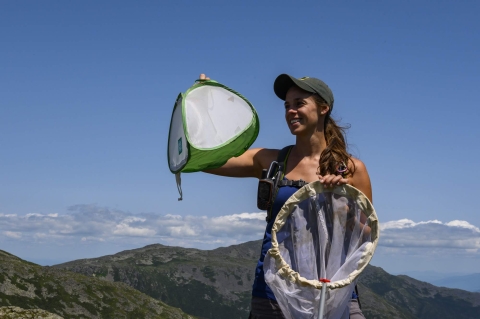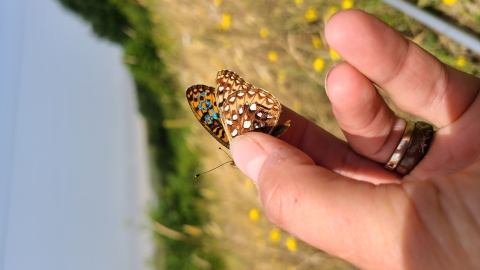People power conservation and this series is to shine a spotlight on some of the folks working hard to protect the nature of America. Samantha Derrenbacher is a biologist for our Ecological Services program in Newport, Oregon. Sam has worked for the U.S. Fish and Wildlife Service for 1 year and shares her story with us.
How did you become interested in conservation or the work that you do?
I believe my love of the environment and strong desire for conservation is literally built into my DNA. To paint a picture for you, my parents were earth and environmental science teachers and my childhood was a never-ending science fair of backyard sandbox volcanos, worm composting, and nature walks. Family vacation centered around hiking up mountains to appreciate the habitat change from mixed deciduous forest to boreal to alpine and following the threads of quartz intrusions along granite paths. My conservation heroes are easy to pick out – they are the people who dedicate their lives to teaching others about the beautiful world around us and eliciting a passion for conservation in the next generation. They are my parents.
What did you study or how did you get involved in public service?
I have a pretty diverse job and interest background – a meandering pathway that started with a degree in Marine Science and eventually lead to becoming a butterfly recovery biologist. Several years ago, I was a technician tracking long-term biological, geological, and physical changes in an estuary setting. And that led me to working in the mountains of New Hampshire with a tiny little butterfly – the White Mountain Fritillary. Each day, as I trekked miles through the alpine zone with a giant net surveying habitat quality, tracking populations, and occasionally catching a fecund (fertile) female to bring back to the lab for captive rearing to enlighten our understanding of the butterfly’s life history, I was inundated with questions from curious hikers. “What are you doing with that giant net?” was the top question. I carefully spent time chatting with each hiker to explain the project, show them the butterfly, and point out how carefully we must be as a group to not step on the plants animals like these rely on. And what a dream. To see that the science I was involved in making leaps of progress toward conserving a rare species and its habitat while getting to share the good news every day while on the job. This unique opportunity led me to the Service – a place where I get to continue to use my passion for protecting threatened species and their habitats while sharing the news about them to anyone willing to ask and listen.
Tell us about your job?
My title reads Wildlife Biologist at the Newport Field Office, a branch of Oregon Fish and Wildlife Ecological Services program. What that means for me is developing, organizing, and maintaining a large diversity of organizations – over 20 of them! – that work directly towards the recovery of the Oregon silverspot butterfly. I provide technical assistance with the Endangered Species Act, such as consultations and advise in developing habitat management plans, and work with university researchers to learn more about the population dynamics and survival requirements of the species. I work with outreach coordinators to develop programs focused on species and habitat conservation and help write grants to fund the plethora of projects. I attend trainings and present on recovery efforts locally and nationally. I spend warm summer days spotting the butterfly, planting native species, assessing habitat quality, and working alongside partners for a net positive effect to the habitat. No day is the same in my line of work.
I find the most interesting part about my job, other than all the incredible people with unique perspectives and diverse background that I work with, is the species I’m focused on. The story woven into the survival of the species is intriguing and elicits a desire for conservation in so many people.
What's your favorite thing about working for the Service?
A large passion of mine is applying ecosystem-based science both to protect the unique beauty of the environment and spread the word throughout the community. The Service is a wonderful opportunity to use that passion for protecting threatened species and their habitats. I haven’t been in this position long, but I am thrilled for the support I’ve found in my colleagues and higher-level supervisors and a shared passion for conservation I have among my teammates.
Which National Wildlife Refuge is your favorite?
I may be biased, but I love Nestucca Bay National Wildlife Refuge on the coast of Oregon. I’ve become intimate with the Cannery Hill prairie as the habitat where the team first reintroduced the Oregon silverspot. The view is stunning, and the prairie is beautifully managed. I also have enjoyed a lot of time working in the Parker River National Wildlife Refuge in Newbury, Massachusetts. The estuary has a complex history and Plum Island is a winter home to snowy owls, which is just so cool.
What advice do you have for someone interested in a career in conservation, public service, and/or with the Service?
I’ve found that people who have made the biggest difference in their careers have a raw passion and belief that what they are doing really makes a difference. That passion also brings an enthusiasm to learn from each opportunity and grow with it to become a better conservationist and public servant. Also, take a ton of field trips – the more we are out in the environments we are working to protect, and alongside others to help the effort and share our dreams with, the more we are equipped to better understand what we are conserving and how to convey those goals to anyone.






